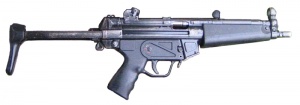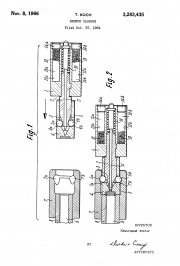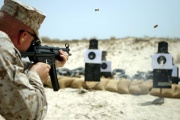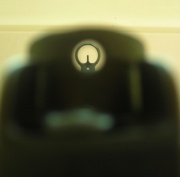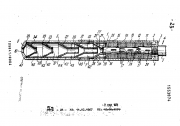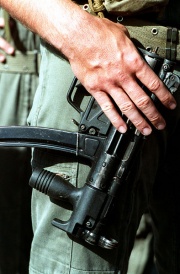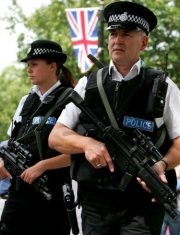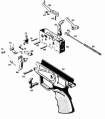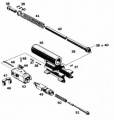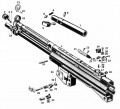Difference between revisions of "Heckler & Koch MP5"
(→References) |
m (1 revision) |
Latest revision as of 15:47, 15 March 2013
| |||||||||||||||||||||||||||||||||||||||||||||||||||||||||||||||||
The MP5 is a 9 mm submachine gun of German design, developed in the 1960s by a team of engineers from the West German arms manufacturer Heckler & Koch GmbH (H&K) of Oberndorf am Neckar. The company, motivated by the success of the G3 automatic rifle, developed a family of small arms consisting of four types of firearms (all based on a common G3 design layout and operating principle), where the first type was chambered in 7.62x51mm NATO, the second – using the 7.62x39mm M43 round, third – the intermediate 5.56x45mm NATO caliber and the fourth type – chambering the 9x19mm Parabellum pistol cartridge. The MP5 (short for Maschinenpistole 5) was created within the fourth group of firearms, initially known as the HK54.
Work on the MP5 began in 1964 and scarcely two years later it was adopted by the German Federal Police, border guard and army special forces. It is currently used by the armed forces and law enforcement units of over 40 different countries. The submachine guns are manufactured under license in several nations including: Greece (Hellenic Arms Industry), Iran (Defense Industries Organization), Mexico (SEDENA), Pakistan (Pakistan Ordnance Factories), Sudan (Military Industry Corporation), Turkey (MKEK), and the United Kingdom (initially at Royal Ordnance, later diverted to Heckler & Koch Great Britain). The MP5 remains one of the most widely deployed of all current submachine guns and has been developed into a family with numerous variants.
Contents |
[edit] Design details
The primary version of the MP5 submachine gun family is the MP5A2, which is a lightweight, air-cooled, selective fire delayed blowback operated weapon with a roller-locked bolt. The weapon fires from a closed bolt (bolt forward) position and the bolt rigidly engages the barrel extension – a cylindrical component welded to the receiver that the barrel is pinned into. The locking mechanism is of the same design as that used in the G3 rifle. The two-part bolt consists of a bolt head with rollers and a bolt carrier. The heavier bolt carrier lies up against the bolt head when the weapon is ready to fire and inclined planes on the front locking piece lie between the rollers and force them out into recesses in the barrel extension. When fired, expanding propellant gases produced from the burning powder in the cartridge exert rearward pressure on the bolt head transferred through the base of the cartridge case. A portion of these forces is transmitted through the locking rollers projecting from the bolt head, which are cammed inward against the inclined flanks of the locking recesses in the barrel extension and to the angled shoulders of the locking piece. The selected angles of the recesses and the incline on the locking piece produce a velocity ratio of about 4:1 between the bolt carrier and the bolt head. This results in a calculated delay, allowing the projectile to exit the barrel and gas pressure to drop to a safe level before the bolt is unlocked and the chamber opened. The delay results from the amount of time it takes for enough recoil energy to be transferred through to the bolt carrier in a sufficient quantity for it to be driven to the rear against the force of inertia of the bolt carrier and the forward pressure exerted against the bolt by the recoil spring. As the rollers are forced inward they displace the locking piece and propel the bolt carrier to the rear. The bolt carrier's rearward velocity is four times that of the bolt head since the bolt remains locked for a short period of time after the initial recoil impulse. After the bolt carrier has traveled rearward 4 mm, the locking piece is withdrawn fully from the bolt head and the locking rollers are compressed into the bolt head (which moves only 1 mm). Only once the locking rollers are fully cammed into the bolt head can the entire bolt group begin its rearward movement in the receiver, breaking the seal in the chamber and repeating the feeding cycle.
Since the 9x19mm Parabellum cartridge is relatively low powered, the bolt does not have an anti-bounce device like the G3, but instead the bolt carrier contains tungsten granules that prevent the bolt group from bouncing back after impacting the barrel extension. The weapon has a fluted chamber that enhances extraction reliability by bleeding gases backwards into the shallow flutes running along the length of the chamber to prevent the cartridge case from expanding and sticking to the chamber walls (since the bolt is opened under relatively high barrel pressure). The MP5 employs a push-type extraction, instead of the more conventional pull-type extraction. The cartridge case is pushed from the chamber of the weapon by residual gas pressure. A spring extractor is installed inside the bolt head and holds the case securely until it strikes the ejector arm and is thrown out of the ejection port to the right of the receiver. The lever-type ejector is located inside the trigger housing (activated by the movement of the recoiling bolt).
The non-reciprocating cocking handle is located above the handguard and protrudes from the cocking handle tube (often mistaken for a gas cylinder) at approx. a 45° angle. This rigid control is attached to a tubular piece within the cocking lever housing called the cocking lever support, which in turn, makes contact with the forward extension of the bolt group. It is not however connected to the bolt carrier and therefore cannot be used as a forward assist to fully seat the bolt group. The cocking handle is held in a forward position by a spring detent located in the front end of the cocking lever support which engages in the cocking lever housing. The lever is locked back by pulling it fully to the rear and rotating it slightly clockwise where it can be hooked into an indent in the cocking lever tube. The cocking lever is generally operated with the non-firing hand, allowing the shooting hand to remain on the pistol grip.
The MP5 has a hammer firing mechanism. The trigger group is housed inside an interchangeable polymer trigger module (with an integrated pistol grip) and equipped with a 3-position fire mode selector that is also the manual safety toggle (selector lever in the “S” or Sicher position in white – weapon safe, “E” or Einzelfeuer in red – single fire, “F”, Feuerstoß also marked in red – continuous fire). The SEF symbols appear on both sides of the plastic trigger group. The selector lever is actuated with the thumb of the shooting hand and is located only on the left side of the of the original SEF trigger group or on both sides of the ambidextrous trigger groups. The safety/selector is rotated into the various firing settings or safety position by depressing the tail end of the lever. Tactile clicks (stops) are present at each position to provide a positive stop and prevent inadvertent rotation. The "safe" setting disables the trigger by blocking the hammer release with a solid section of the safety axle located inside the trigger housing.
The first MP5 models used a double-column straight box magazine, but since 1977, slightly curved, steel magazines are used with a 15-round capacity (weighing 0.12 kg) or a 30-round capacity (0.17 kg empty).
The sighting arrangement on the MP5 takes advantage of the natural ability of the eye and brain to easily align concentric circles (circles all having a common center). The mechanically adjustable iron sights (closed type) consist of a rotating rear diopter drum and a front post installed in a hooded ring. The rear sight is adjustable for both windage and elevation with the use of a special tool; the drum provides four different apertures of varying width used for firing at 25, 50, 75 and 100 m. However, adjusting the rear drum does not change the elevation or bullet strike of the rounds since the MP5 uses pistol cartridges, which share a similar point of impact between 25 and 100 m when zeroed at 25 m. The receiver housing has notches that permit the attachment of a standard H&K quick-detachable scope mount (also used with the G3, HK33 and G3SG/1) that can be used to mount daytime optical sights (telescopic 4x24), night sights or a halogen flashlight. It can also be used with reflex sights and laser pointers. The mount features two spring-actuated bolts, positioned along the base of the mount, which exert pressure on the receiver to hold the mount in the same position at all times assuring zero retention. All versions of the quick-detachable scope mount provide a sighting tunnel through the mount so that the shooter can continue to use the fixed iron sights with the scope mount attached to the top of the receiver.
The fixed, free floating, cold hammer-forged barrel has 6 right-hand grooves with a 1 in 250 mm (1:10 in) rifling twist rate and is pressed and pinned into the receiver. Three lugs are provided at the muzzle that are used to work with certain muzzle devices made by Heckler & Koch, including: a slotted flash suppressor, blank firing attachment (marked with a red painted band denoting use with blank ammunition only), an adaptor for launching rifle grenades (for use with rifle-style grenades with an inside diameter of 22 mm using a special grenade launching cartridge) and a cup-type attachment used to launch tear gas grenades.
The MP5A2 has a fixed stock (made of a synthetic polymer), whereas the compact MP5A3 has a retractable metal stock.
Included with the MP5A2 and MP5A3 are: sling, cleaning kit, quick-loading device and a clamp which holds two magazines. As an option, tritium-illuminated sights are also available (used for firing in low-level lighting conditions) as well as sound suppressors from several aftermarket manufacturers.
In the early 1970s HK introduced a conversion kit for the MP5 that enables it to use sporting ammunition (.22 LR). This unit consists of a barrel insert, a bolt group and two 20-round magazines. This modification reduces the cyclic rate to 650 rounds/min.
The MP5A2 and MP5A3 submachine guns are also available with optional 4-position trigger groups; such equipped weapons are known as the MP5A4 and MP5A5 (respectively). The trigger groups are marked with bullet pictograms rather than letters or numbers (each symbol represents the number of bullets that will be fired when the trigger is pulled and held rearward with a full magazine inserted in the weapon) and are fully ambidextrous (the selector lever is present on each side of the trigger housing). The additional setting of the fire selector, one place before the fully automatic setting, enables a two or three-shot burst firing mode. H&K also offers dedicated training variants of these weapons, designated MP5A4PT and MP5A5PT (PT - Plastic Training), modified to fire a plastic 9x19mm PT training cartridge produced by Dynamit Nobel of Germany. These weapons operate like the standard MP5 but have a floating chamber and the bolt lacks both rollers to function properly when firing the lighter plastic projectiles. To help identify these weapons blue dots were painted on their cocking handles and additional lettering provided. The PT variant can be configured with various buttstocks and trigger groups and was developed for the West German Police and Border Guard.
Thanks to the modular design of the MP5, particularly the trigger groups, a large number of configurations are available to meet the user’s individual requirements. Currently offered are the following trigger groups: three-position "SEF" fire selector (positions: "S"-safe, "E"-semi automatic, "F" fully automatic. Located on left of receiver only); three-position fire selector (positions: safe, semiautomatic and a 2 or 3-round burst; selector lever is ambidextrous and its settings are marked with pictograms); four-position fire selector (positions: weapon safe, single fire, 2 OR 3-round burst, full auto; ambidextrous selector; selector settings marked with pictograms); two-position fire control group (positions: weapon safe, single fire only; ambidextrous selector lever with pictograms) and a three-position fire selector group - the so called “Navy” trigger (settings: weapon safe, semi-automatic, fully automatic fire; ambidextrous selector lever; selector settings marked with bullet symbols again).
A variant with the last trigger group designated the MP5-N (N – Navy) was developed in 1986 for the United States Navy Special Warfare community. This model has a collapsible stock, a tritium-illuminated front sight post and a 225 mm (8.9 in) threaded barrel for use with a stainless steel sound suppressor made by KAC (when suppressed subsonic ammunition is used).
|
|
The two-position trigger unit was also used in the single-fire HK94 carbine that was produced specifically for the civilian market with a 420 mm (16.5 in) barrel.
In 1974 H&K initiated design work on a sound-suppressed variant of the MP5, designated the MP5SD (SD – Schalldämpfer or "suppressed"), which features an integral but detachable aluminum sound suppressor and a lightweight bolt. The weapon's 146 mm (5.7 in) barrel has 30 2.5 mm (0.1 in) ports drilled forward of the chamber through which escaping gases are diverted to the surrounding sealed tubular casing that is screwed on to threading on the barrel’s external surface just prior to the ported segment. The suppressor itself is divided into two stages; the initial segment surrounding the ported barrel serves as an expansion chamber for the propellant gases, reducing gas pressure to slow down the acceleration of the projectile. The second, decompression stage occupies the remaining length of the suppressor tube and contains a stamped metal helix separator with several compartments which increase the gas volume and decrease its temperature, deflecting the gases as they exit the muzzle, so muffling the exit report. The bullet leaves the muzzle at subsonic velocity, so it does not generate a sonic shock wave in flight. As a result of reducing the barrel’s length and venting propellant gases into the suppressor, the bullet’s muzzle velocity was lowered anywhere from 16% to 26% (depending on the ammunition used) while maintaining the weapon’s automation and reliability. The weapon was designed to be used with standard supersonic ammunition with the suppressor on at all times.
The MP5SD is produced exclusively by H&K in several versions: the MP5SD1 and MP5SD4 (both have a receiver end cap instead of a buttstock), MP5SD2 and MP5SD5 (equipped with a fixed synthetic buttstock) and the MP5SD3 and MP5SD6 (fitted with a collapsible metal stock). The MP5SD1, MP5SD2 and MP5SD3 use a standard "SEF" trigger group (from the MP5A2 and MP5A3), while the MP5SD4, MP5SD5 and MP5SD6 – a trigger module with a mechanically limited 3-round burst mode and ambidextrous selector controls (from the MP5A4 and MP5A5). A suppressed version was also produced for the U.S. Navy - designated the MP5SD-N, which is a version of the MP5SD3 with a retractable metal stock, front sight post with tritium-illuminated dot and a stainless steel suppressor. This model has a modified cocking handle support to account for the slightly larger outside diameter of the suppressor. The design of the suppressor allows the weapon to be fired with water inside, should water enter the device during operation in or near water.
In 1976 a shortened version of the MP5A2 was introduced; the MP5K (K – Kurz) was designed with clandestine operations and special services in mind primarily for close quarters battle. This submachine gun does not have a shoulder stock (the receiver end was covered with a flat cover), and the bolt and receiver were shortened at the rear. The resultant lighter bolt led to a higher rate of fire than the standard MP5. The barrel, cocking handle and its cover were shortened and a vertical foregrip was used to replace the standard handguard. The barrel ends at the base of the foresight, which prevents the use of any sort of muzzle device.
MP5K submachine guns are produced (by HK and under license in Iran and Turkey) in four different versions: the MP5K, MP5KA4, MP5KA1, MP5KA5, where the first two variants have adjustable, open-type iron sights (with a notched rotary drum), and the two remaining variants - fixed open sights, however the front sight post was changed and a notch was cut into the receiver top cover. The MP5K retained the capability to use optical sights through the use of an adapter.
A civilian semiautomatic derivative of MP5K known as the SP89 was produced that had a foregrip with a muzzle guard in place of the vertical grip.
In 1991 a further variant of the MP5K was developed, designated the MP5K-PDW (PDW – Personal Defense Weapon) that retained the compact dimensions of the MP5K but restored the fire handling characteristics of the full-size MP5A2. The MP5K-PDW uses a side-folding synthetic shoulder stock (made by the US company Choate), a “Navy” trigger group, a front sight post with a built-in tritium insert and a slightly lengthened threaded, three-lug barrel (analogous to the MP5-N). The stock can be removed and replaced with a receiver endplate; a rotary drum with apertures from the MP5A2 can also be used.
1991 saw the introduction of the nearly identical MP5/10 (chambered in 10mm Auto) and MP5/40 (chambered for the .40 S&W cartridge) submachine guns, which are based on the MP5A4 and MP5A5. These weapons were assembled in fixed and retractable stock configurations (without a separate designation) and are fed from translucent 30-round polymer box magazines. These weapons also include a bolt hold-open device, which captures the bolt group in its rear position after expending the last cartridge from the magazine. The bolt is then released by pressing a lever positioned on the left side of the receiver. Both weapons use a barrel with 6 right-hand grooves and a 380 mm (1:15 in) twist rate, and like the MP5-N, both have a 3-lugged muzzle device and a tritium-illuminated front sight aiming dot.
[edit] Variants
- MP5A1: No buttstock (endplate/receiver cap in place of buttstock), "Navy"/"SEF" trigger group.
- MP5A2: Fixed buttstock, "SEF" trigger group.
- MP5SFA2: Fixed buttstock, single-fire (SF) trigger group.
- MP5A3: Retractable buttstock,"SEF" trigger group.
- MP5SFA3: Retractable buttstock, single-fire (SF) trigger group.
- MP5A4: Fixed buttstock, 3-round burst trigger group.
- MP5A5: Retractable buttstock, 3-round burst trigger group.
- MP5-N: Model developed specifically for the U.S. Navy. Ambidextrous "Navy" trigger group, 3-lug/threaded barrel for attaching a sound suppressor; retractable stock.
- MP5F: Model developed specifically for the French military. Rubber-padded retractable stock, ambidextrous sling loops/bolts and internal modifications to handle high-pressure ammunition.
- MP5K: Short (Kurz) version, "SEF" trigger group.
- MP5KA1: MP5K with smooth upper surface and small iron sights; "SEF" trigger group.
- MP5KA4: MP5K with 3-round burst trigger group.
- MP5KA5: MP5KA1 with 3-round burst trigger group.
- MP5K-N: MP5K with "Navy" trigger group and 3-lug/threaded barrel for mounting suppressors or other muzzle attachments.
- MP5K-PDW: Personal Defense Weapon; MP5K-N with added folding stock and 3-lug/threaded barrel for mounting of suppressors; "Navy" or 3-round burst trigger group. Introduced in 1991.
- MP5SD1: No buttstock (endplate/receiver cap in place of buttstock), "SEF" trigger group, integrated suppressor (Schalldämpfer)
- MP5SD2: Fixed buttstock, "SEF" trigger group, integrated suppressor.
- MP5SD3: Retractable buttstock, "SEF" trigger group, integrated suppressor.
- MP5SD4: No buttstock (endplate/receiver cap in place of buttstock), 3-round burst trigger group, integrated suppressor.
- MP5SD5: Fixed buttstock, 3-round burst trigger group, integrated suppressor.
- MP5SD6: Retractable buttstock, 3-round burst trigger group, integrated suppressor.
- MP5SD-N: Retractable buttstock, "Navy" trigger group, KAC stainless steel suppressor.
- MP5/10: Chambered in 10mm Auto, available in various stock/trigger group configurations. It was produced from 1992 to 2000.
- MP5/40: Chambered in .40 S&W, available in various stock/trigger group configurations. It was produced from 1992 to 2000.
- HK94: American import model of the MP5 with a 16 in barrel and special safe/semi-automatic trigger group, designed for civilian use. It was made from 1983 to 1989, in three different configurations.
- SP89: Sport Pistole M1989. Semi-automatic only version of the MP5K designed for civilian use. It had a modified foregrip redesigned into a traditional handguard that did not allow the fitting of the MP5K's foregrip to make it compliant with the Semi-Auto Weapons Ban of 1989. It was made from 1989 to 1994.
- HK54: This was the original model that was produced in the mid 1960s. It later became known as the MP5A1, a very slightly modified version.
[edit] Users
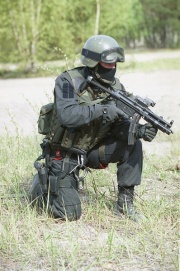
- Afghanistan
- Albania: Albanian Special forces RENEA and the Albanian Police, further procurement for regular armed forces planned.
- Algeria: Algerian Airborne Commando Division.
- Argentina: Used by GEOF, Hawk Special Operations Brigade and Argentine Naval Prefecture
- Australia: Australian Army—4th Battalion (Commando), Special Air Service Regiment, Royal Australian Air Force No. 1 & No. 2 Airfield Defence Squadrons and various Australian Federal and State law enforcement units.
- Azerbaijan: Azerbaijan Interior Guard.
- Bahrain
- Bangladesh: Army, Special Forces, Rapid Action Battalion.
- Belgium: Gespecialiseerde Verkenningsploegen (GVP) / Equipes Specialisees de Reconnaissance (ESR), Speciaal Interventie-Eskadron (SIE) / Escadron Special d'Intervention (ESI).
- Brazil: Brazilian Army special forces and several, state police departments and Military Police (BOPE, Polícia Militar do Estado de São Paulo, Polícia Militar do Estado do Rio de Janeiro)
- Cameroon
- Canada: Various police tactical units, RCMP ERTs, Joint Task Force Two (JTF-2), naval boarding parties, Emergency Task Force (ETF Toronto).
- Chile: 1st Battalion Airborne Forces. Unidad Anti-Terroristas (UAT).
- Colombia: Lanceros, Agrupacion de Fuerzas Especiales Urbanas (AFEU).
- Democratic Republic of the Congo
- Croatia: Special police tactical units.
- Cyprus: Police.
- Czech Republic
- Denmark: Danish police and special forces.
- Egypt
- El Salvador
- Finland: Finnish police and Finnish Defence Forces. Designated 9.00 KP 2000.[2]
- France: Used by the Groupe d'Intervention de la Gendarmerie Nationale, French Foreign Legion, Commandement des Operations Speciales (COS), Groupement Speciale Autonome and certain specialized units within the French Army (MP5A5 and MP5SD3 variants).[3][4]
- Germany: German State Police, German Federal Police, KSK, Kampfschwimmer, Long Range Reconnaissance Company, Feldjäger (military police), GSG 9. The German Army and German Navy also employ the MP5K.
- Ghana
- Greece: Police and Greek Special Forces Directorate. Weapons are manufactured locally by Hellenic Defence Systems (EAS: Ellinika Amyntika Systimata).[5]
- Honduras
- Hong Kong: Special Duties Unit.
- Hungary: Used by the Hungarian Police, Hungarian Prison Service and Hungarian Ground Forces.
- Iceland: Icelandic Coast Guard, Icelandic Crisis Response Unit and Special Forces of the National Commissioner.
- India: Indian Army special forces, National Security Guards, MARCOS and other units.
- Indonesia: Indonesian National Armed Forces counter-terrorism unit.
- Iran: Islamic Republic of Iran Army, Iranian police.
- Ireland: Sciathan Fianoglach an Airm (Irish Army Rangers).
- Italy: GIS, NOCS and other special operating forces such as COMSUBIN.
- Jamaica: Jamaica Constabulary Force (JCF).
- Japan: Japanese Special Operations Group and Special Assault Team
- Jordan: SOU-17.
- Kenya
- Kuwait: Kuwait Army.
- Latvia: Speciālo Uzdevumu Vienība (special forces) and military police.
- Lebanon: 101st Parachute Company.
- Lithuania[6]
- Luxembourg
- Macao: Unidade Táctica de Intervenção da Polícia , Grupo de Operações Especiais , Grupo de Protecção de Altas Entidades e Instalações Importantes.
- Macedonia: Macedonian Special Forces.
- Malaysia: Malaysian Armed Forces, various special forces units and law enforcement agencies.
- Malta
- Mauritius
- Mexico: The Mexican Army, Mexican Navy, Mexican Marines, Fuerzas Especiales and law enforcement agencies such as state, federal and military police. Licence produced by SEDENA.
- Montenegro: Vojska Crne Gore (VCG).
- Morocco: Royal Moroccan Armed Forces, G.S.I.G.R., National Police Force, Gendarmerie Royale.
- Netherlands: Netherlands Marine Corps, Royal Marechaussee military police, DSI counter-terrorism unit and several other police formations.
- New Zealand: 1st Special Air Service Squadron.
- Niger
- Nigeria
- Norway: Norwegian Defence Force (The MP7 is set to replace the MP5) [7], Beredskapstroppen and Norwegian Police.
- Pakistan: Pakistan Army standard weapon for close range engagements, built by Pakistan Ordnance Factories under license from HK.[8]
- Peru
- Philippines: Armed Forces of the Philippines, and Philippine National Police Special Action Force and other police and SWAT units.
- Poland: GROM, police special units.
- Portugal: Various military units, including the Portuguese Army Special Operations and the Portuguese Marine Corps Special Actions Detachment (DAE). Also used by law enforcement agencies Polícia de Segurança Pública, including the Special Operations Group (GOE), and the Portuguese National Republican Guard (GNR), Policia do Exército (PE).
- Qatar
- Romania: SRI (Serviciul Român de Informaţii) counter-terrorism unit and certain police units.
- Saudi Arabia: Special Forces Brigade.
- Serbia: SAJ (Special Anti-terrorist Unit), UBPOK, Serbian Military Police and several other police and military formations.
- Singapore: Singapore Armed Forces Commandos, Singapore Police Force.
- Slovakia: Slovak police and special forces.
- Slovenia: Police and special forces.
- South Africa: Various services.
- South Korea: ROKA 707th Special Missions Battalion, ROKN Naval Special Warfare Brigade (UDT/SEAL), KNP Special Weapons Attack Team (SWAT), ROKCG Sea Special Assault Team (SSAT).
- Spain: Various units, including the UOE and the Tercio de Extranjeros y de Moreria. Also GOE (Grupo de Operaciones Especiales), GOES (Grupo Operativo Especial de Seguridad), GEO (Grupo Especial de Operaciones)[9] and GEI (Grup Especial d'Intervenció (from Catalonia).
- Sri Lanka: Sri Lanka Army Commando Regiment, Special Task Force.
- Sudan: Manufactured under a license agreement by Military Industry Corporation as the Tihraga.[10]
- Switzerland: FSK-17 and several Swiss police departments (including SWAT- Teams)
- Sweden: National Taskforce (NI), and Piketen, Swedish Police.
- Taiwan: Republic of China Army and Republic of China Military Police, Republic of China Marine Corps Frogmen, Republic of China Coast Guard and various Police SWAT and special forces.
- Thailand: Used by the Royal Thai Police.
- Turkey: Various services. Built under license from HK by MKEK.[11]
- United Arab Emirates: UAE Special Forces, Abu Dhabi Police SWAT, Dubai Police SWAT, UAE VIP Protection Team.
- United Kingdom: UKSF, Specialist Firearms Command, Firearms Unit, Police Service of Northern Ireland, Special Air Service.
- United States: Issued to the Marine Corps Force Reconnaissance Companies, Marine Security Force Battalions, and Special Operations Units, such as Army Rangers, Delta Force, Navy SEALs, Air Force Combat Control, military law enforcement units and countless civilian law enforcement departments and federal agencies. Civilian ownership is legal in most states but tightly regulated by the National Firearms Act and currently limited to units produced before May 1986.
- Uruguay
- Vietnam: Battalion special police.
- British Virgin Islands: Maritime Patrol officers as well as armored car guards use the MP5K.
- ↑ globalsecurity.org
- ↑ Puolustusvoimat: Kalustoesittely
- ↑ Terre - HK MP5 A5
- ↑ Terre - HK MP5 SD3
- ↑ Hellenic Defense Systems
- ↑ http://soj.lt/ginklai_technika/
- ↑ En liten røver med trøkk i (Norwegian article on the Heckler & Koch deal)
- ↑ http://www.pof.gov.pk/products/smgs.htm
- ↑ Web Del Grupo Especial De Operaciones (G.E.O.)
- ↑ Military Industry Corporation (MIC) Official Website
- ↑ MKEK
[edit] See also
[edit] Resources
The Gun Owners' Resource Online Library has the following documents available for free download for the Heckler & Koch MP5 submachine gun and its variants:
- Heckler & Koch MP5 Submachine gun family Operator's Manual - draft version by HK (5MB .PDF file, 117pgs)
The following image files are also available for reference:
[edit] External links
- Heckler & Koch – official pages: MP5A series, MP5SD, MP5-N, MP5K, MP5SF
- MP5 operator's manual
- 2008 Heckler & Koch Military and LE brochure
- HKPRO
- Modern Firearms
- REMTEK
- Video of operation (MP5A3) (Japanese)
- Video of operation (MP5SD2) (Japanese)
[edit] References
| Handguns | M9 | M11 | MEU(SOC) | Mk 23 | Mk 24 | |
|---|---|---|
| Rifles | Assault and Battle | M16 | Mk 14 | Mk 17 |
| Carbine | HK416 | M4 | Mk 18 | |
| Designated Marksman | DMR | M14 | M39 | Mk 12 | SAM-R | SDM-R | SEAL Recon Rifle | |
| Sniper | M24 | M40 | M107 | M110 | Mk 11 | Mk 15 | |
| Shotguns | M26 | M590 | M870 | M1014 | |
| Submachine guns | MP5N | P90 | |
| Machine guns | M2HB (still!) | M240B | M249 and Mk 46 | Mk 43 | |
| Grenade launchers | M203 | M32 | M320 | M79 | Mk 19 | Mk 47 | |
| Mortars | M120 | M224 | M252 | |
| Rockets | M3 | M72 series | M136 | M141 | M202A1 | Mk 153 | |
| Missiles | FGM-172 | FGM-148 | FIM-92 | |
| Cartridges | 12-gauge | 5.7x28mm | 9x19mm NATO | .45 ACP | 5.56x45mm NATO | 7.62x51mm NATO | .50 BMG (12.7x99mm NATO) | 40x46mm | |
| This article is part of a series on Heckler & Koch firearms | ||
|---|---|---|
| Handguns | HK4 · VP70 · P9 · P7 · Mark 23 · USP · P2000 · P30 · HK45 | 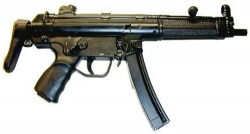 |
| Military Semi-auto & Select-fire Rifles | G3 · HK33 · PSG1 · G41 · G36 · HK416 · HK417 | |
| Civilian Rifles | HK41 · HK43 · SL6 · SL7 · SL8 · SR9 | |
| Shotguns | FABARM FP6 | |
| Submachine guns | MP5 (duh!) · UMP · MP7 | |
| Machine guns | HK21 · MG4 | |
| Grenade launchers | HK69A1 · AG-C/GLM · AG36 · M320 · GMG | |
| Prototypes | Handguns — P46 Rifles — HK32· HK36· G11· XM29 OICW· XM8 Shotguns — HK CAWS | |
| Other Stuff | P2A1 · P11 · 4.6x30mm | |
